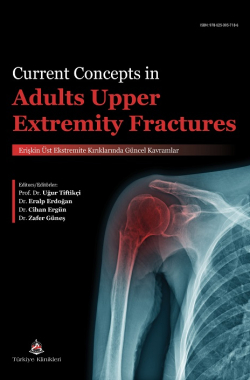IMAGING AND DIAGNOSTIC TESTS IN ELBOW REGION FRACTURES
Kubilay Uğurcan Ceritoğlu1 Onur Yılmaz2
1Çanakkale Onsekiz Mart University, Faculty of Medicine, Department of Orthopedics and Traumatology, Çanakkale, Türkiye
2Çanakkale Mehmet Akif Ersoy State Hospital, Department of Orthopedics and Traumatology, Çanakkale, Türkiye
Ceritoğlu KU, Yılmaz O. Imaging and Diagnostic Tests in Elbow Region Fractures. In: Tiftikçi U, Erdoğan E, Ergün C, Güneş Z, editors. Current Concepts in Adults Upper Extremity Fractures. 1st ed. Ankara: Türkiye Klinikleri; 2025. p.159-166.
ABSTRACT
Elbow fractures are common injuries that often pose significant diagnostic and therapeutic challenges due to their complex nature. These injuries, prevalent among both adults and children, may result from various trauma mechanisms such as falls, sports-related accidents, or high-energy impacts. Early and accurate diagnosis is essential to prevent complications like stiffness, chronic pain, instability, or deformity.
The diagnostic process begins with a comprehensive patient history and physical examination. Key clinical signs, such as limited range of motion, point tenderness, swelling, and the presence of ecchymosis, can indicate potential fractures or ligament injuries. Tests like the elbow extension test and stress tests for varus/valgus instability play a pivotal role in identifying subtle injuries that may not be immediately apparent.
Imaging serves as a cornerstone in the diagnosis and management of elbow fractures. Radiography is typically the first-line imaging modality due to its widespread availability, cost-effectiveness, and high sensitivity for detecting bony injuries. Radiographs must be taken with the ideal technique in order to make the correct diagnosis. However, radiographs can be limited in their ability to detect non-displaced fractures or associated soft tissue injuries, necessitating advanced modalities such as computed tomography (CT) or magnetic resonance imaging (MRI). CT provides detailed visualization of complex fractures, while MRI excels in assessing ligament, tendon, and cartilage injuries. Additionally, ultrasound is emerging as a valuable, non-invasive, and radiation-free tool, particularly in pediatric populations where minimizing radiation exposure is a priority.
This chapter provides a comprehensive review of diagnostic strategies for elbow fractures, detailing the utility of various imaging modalities and clinical tests. By integrating findings from physical examination with advanced imaging techniques, clinicians can achieve greater diagnostic accuracy, optimize treatment planning, and improve patient outcomes. The development of new imaging technologies holds promise for further enhancing the diagnostic process while reducing radiation exposure and improving accessibility.
Keywords: Elbow injuries; Elbow fractures; Elbow; Radiography; Tomography; Ultrasonography
Kaynak Göster
Referanslar
- Jacoby SM, Herman MJ, Morrison WB, Osterman AL. Pediatric elbow trauma: an orthopaedic perspective on the importance of radiographic interpretation. Semin Musculoskelet Radiol. 2007;11(1):48-56. [Crossref] [PubMed]
- Baker M, Borland M. Range of elbow movement as a predictor of bony injury in children. Emerg Med J. 2011;28(8):666-9. [Crossref] [PubMed]
- Blumberg SM, Kunkov S, Crain EF, Goldman HS. The predictive value of a normal radiographic anterior fat pad sign following elbow trauma in children. Pediatr Emerg Care. 2011;27(7):596-600. [Crossref] [PubMed]
- Appelboam A, Reuben AD, Benger JR, Beech F, Dutson J, Haig S, et al. Elbow extension test to rule out elbow fracture: multicentre, prospective validation and observational study of diagnostic accuracy in adults and children. BMJ. 2008;337:a2428. [Crossref] [PubMed] [PMC]
- Darracq MA, Vinson DR, Panacek EA. Preservation of active range of motion after acute elbow trauma predicts absence of elbow fracture. Am J Emerg Med. 2008;26(7):779-82. [Crossref] [PubMed]
- Jie KE, van Dam LF, Verhagen TF, Hammacher ER. Extension test and ossal point tenderness cannot accurately exclude significant injury in acute elbow trauma. Ann Emerg Med. 2014;64(1):74-8. [Crossref] [PubMed]
- Karbach LE, Elfar J. Elbow Instability: Anatomy, Biome chanics, Diagnostic Maneuvers, and Testing. J Hand Surg Am. 2017;42(2):118-26. [Crossref] [PubMed] [PMC]
- Crosby NE, Greenberg JA. Radiographic Evaluation of the Elbow. The Journal of Hand Surgery. 2014;39(7):1408-14. [Crossref] [PubMed]
- Ehsan H, Apostolou N, Mohammad Aref M, Mohammd Hossein N. Step by Step Approach to Interpretation of Pediatric Elbow Radiography. Journal of Orthopedic and Spine Trauma. 2020;5(1).
- Greenspan A, Norman A, Rosen H. Radial head-capitellum view in elbow trauma: clinical application and radiographic-anatomic correlation. AJR Am J Roentgenol. 1984;143(2):355-9. [Crossref] [PubMed]
- Skibo L, Reed MH. A criterion for a true lateral radiograph of the elbow in children. Can Assoc Radiol J. 1994;45(4):287-91.
- De Maeseneer M, Jacobson JA, Jaovisidha S, Lenchik L, Ryu KN, Trudell DR, et al. Elbow effusions: distribution of joint fluid with flexion and extension and imaging implications. Invest Radiol. 1998;33(2):117-25. [Crossref] [PubMed]
- Skaggs DL, Mirzayan R. The posterior fat pad sign in association with occult fracture of the elbow in children. J Bone Joint Surg Am. 1999;81(10):1429-33. [Crossref] [PubMed]
- O'Dwyer H, O'Sullivan P, Fitzgerald D, Lee MJ, McGrath F, Logan PM. The fat pad sign following elbow trauma in adults: its usefulness and reliability in suspecting occult fracture. J Comput Assist Tomogr. 2004;28(4):562-5. [Crossref] [PubMed]
- Kumar M, Lakhey RB, Shrestha BL. Radiographic measurement of Lateral Capitellohumeral Angle and Baumann's Angle among Children. J Nepal Health Res Counc. 2022;20(2):296-300. [Crossref] [PubMed]
- Generoso TO, Pacifico Junior GM, Barcelos FM, Blumetti FC, Braga SR, Ramalho Junior A. The Baumann Angle: An Analysis from Theory to Practice. Rev Bras Ortop (Sao Paulo). 2022;57(6):1039-44. [Crossref] [PubMed] [PMC]
- Hanlon DP, Mavrophilipos V. The Emergent Evaluation and Treatment of Elbow and Forearm Injuries. Emergency Medicine Clinics of North America. 2020;38(1):81-102. [Crossref] [PubMed]
- Kim HH, Gauguet JM. Pediatric Elbow Injuries. Semin Ultrasound CT MR. 2018;39(4):384-96. [Crossref] [PubMed]
- Stanborough RO, Wessell DE, Elhassan BT, Schoch BS. MRI of the Elbow: Interpretation of Common Orthopaedic Injuries. J Am Acad Orthop Surg. 2022;30(6):e573-e83. [Crossref] [PubMed]
- Nguyen ML, Wong PK, Gangasani NR, Rowe JS, Salastekar NV, Hanna TN. Imaging Review of Adult Elbow Fractures and Dislocations in the Emergency Department. Radiographics. 2023;43(7):e220131. [Crossref] [PubMed]
- Avci M, Kozaci N, Beydilli I, Yilmaz F, Eden AO, Turhan S. The comparison of bedside point-of-care ultrasound and computed tomography in elbow injuries. Am J Emerg Med. 2016;34(11):2186-90. [Crossref] [PubMed]
- Rabiner JE, Khine H, Avner JR, Friedman LM, Tsung JW. Accuracy of point-of-care ultrasonography for diagnosis of elbow fractures in children. Ann Emerg Med. 2013;61(1):9-17. [Crossref] [PubMed]

